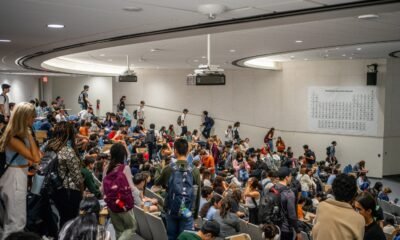Education
Apprenticeships for high schoolers are touted as the next big thing. One state leads the way

This story is part of Hechinger’s ongoing coverage about rethinking high school. See our articles about a new diploma in Alabama and a “career education for all” model in Kentucky.
ELKHART, Ind. — Ever since Ty Zartman was little, people told him he had to go to college to be successful. “It was engraved on my brain,” he said.
But despite earning straight A’s, qualifying for the National Honor Society, being voted prom king and playing on the high school football and baseball teams, the teen never relished the idea of spending another four years in school. So in fall 2023 he signed up through his Elkhart, Indiana, high school for an apprenticeship at Hoosier Crane Service Company, eager to explore other paths. There, he was excited to meet coworkers who didn’t have a four-year degree but earned good money and were happy in their careers.
Through the youth apprenticeship, Ty started his day at the crane manufacturing and repair business at 6:30 a.m., working in customer service and taking safety and training courses while earning $13 an hour. Then, he spent the afternoon at his school, Jimtown High, in Advanced Placement English and U.S. government classes.
In June, the 18-year-old started full-time at Hoosier Crane as a field technician.
“College is important and I’m not dissing on that,” Ty said. “But it’s not necessarily something that you need.”
Elkhart County is at the forefront of a movement slowly spreading across Indiana and the nation to make apprenticeships a common offering in high school.
In 2019, as part of a plan to boost the region’s economic prospects, county leaders launched an effort to place high schoolers in apprenticeships that combine work-based training with classroom instruction. About 80 students from the county’s seven school districts participated this academic year, in fields such as health care, law, manufacturing, education and engineering. In April, as part of a broader push to revamp high school education and add more work-based learning, the state set a goal of 50,000 high school apprentices by 2034.
Tim Pletcher, the principal of Jimtown High, said students are often drawn first to the chance to spend less time in class. But his students quickly realize apprenticeships give them work-based learning credits and industry connections that help them after graduation. They also earn a paycheck. “It’s really causing us to have a paradigm shift in how we look at getting kids ready for the next step,” he said.
Related: Become a lifelong learner. Subscribe to our free weekly newsletter featuring the most important stories in education.
This “earn and learn” model is taking hold in part because of deepening disillusionment with four-year college, and the fact that well-paying jobs that don’t require bachelor’s degrees are going unfilled nationally. The past three presidential administrations invested in expanding apprenticeships, including those for high schoolers, and in April, President Donald Trump signed an executive order calling for 1 million new apprentices. In a recent poll, more than 80 percent of people said they supported expanding partnerships between schools and businesses to provide work-based learning experiences for students.
Yet in the United States, the number of so-called youth apprenticeships for high schoolers is still “infinitesimally small,” said Vinz Koller, a vice president at nonprofit group Jobs for the Future. One estimate suggests they number about 20,000 nationally, while there are some 17 million high school students. By contrast, in Switzerland — which has been praised widely for its apprenticeship model, including by U.S. Education Secretary Linda McMahon — 70 percent of high schoolers participate. Indiana is among several states, including Colorado, South Carolina and Washington, that have embraced the model and sent delegations to Switzerland to learn more.
Experts including Ursula Renold, professor of education systems at the Swiss Federal Institute of Technology (ETH) Zurich, note that importing the model to the United States at a large scale won’t be simple. Most businesses aren’t accustomed to employing apprentices, parents can be resistant to their students trading four-year college aspirations for work, and public transportation to take students to apprenticeships is limited, especially in rural areas. Many high schoolers don’t have a driver’s license, access to a car or money for gas. School districts already face a shortage of bus drivers that makes transporting students to apprenticeships difficult or impossible.
Still, Renold, who is known as the “grande dame of apprenticeships,” said Indiana’s commitment to apprenticeships at the highest levels of state government, as well as the funding the state has invested in work-based learning, at least $67 million, seem to be setting the state up for success, though it could take a decade to see results.
“If I had to make a bet,” said Renold, “I would say it’s Indiana who will lead the way.”
Related: Apprenticeships are a trending alternative to college, but there’s a hitch
Elkhart County’s experiment with apprenticeships has its roots in the Great Recession. Recreational vehicle manufacturing dominates the local economy, and demand for the vehicles plummeted, contributing to a regional unemployment rate at that time of nearly 20 percent. Soon after, community leaders began discussing how to better insulate themselves from future economic instability, eventually focusing on high school education as a way to diversify industries and keep up with automation, said Brian Wiebe, who in 2012 founded local nonprofit Horizon Education Alliance, or HEA, to help lead that work.

That year, Wiebe and two dozen local and state political, business, nonprofit and education leaders visited Switzerland and Germany to learn more about the apprenticeship model. “We realized in the U.S., there was only a Plan A, a path to college,” he recalled. “We were not supporting the rest of our young people because there was no Plan B.”
HEA partnered with Elkhart County school districts and businesses, as well as with CareerWise, a youth apprenticeship nonprofit that works nationally. They began rolling out apprenticeships in 2019, eventually settling on a goal of increasing participation by 20 percent each year.
In 2021, Katie Jenner, the new secretary of education for Indiana, learned about Elkhart’s apprenticeships as she was trying to revamp high school education in the state so it better prepared students for the workforce. Elkhart, as well as six other apprenticeship pilot sites funded by Indianapolis-based philanthropy the Richard M. Fairbanks Foundation, provided a proof of concept for the apprenticeship model, said Jenner.
In December, the state adopted a new diploma system that includes an emphasis on experiential and work-based learning, through apprenticeships, internships and summer jobs.
Related: Schools push career ed classes ‘for all,’ even kids heading to college
On a weekday this winter, 17 sophomores at Elkhart’s Concord High School were sitting at computers, creating resumes they planned to use to apply for apprenticeships. The students were among some 50 sophomores at the high school who’d expressed interest in apprenticing and met the school’s attendance and minimum 2.5 GPA requirements, out of a class of roughly 400. They would receive coaching and participate in mock interviews before meeting with employers.
Becca Roberts, a former English teacher who now oversees the high school’s college and career programs, said apprenticeships help convince students of the importance of habits like punctuality, clear communication and regular attendance. “It’s not from a book,” she said. “They’re dealing with real life.”

One student, Ava Cripe, said she hoped for an apprenticeship of some sort in the health care field. She’d only been a pet sitter and was nervous at the thought of having a professional job. “You’re actually going out and working for someone else, like not for your parents or your grandma, so it’s a little scary,” she said.
CareerWise Elkhart has recently beefed up its support for students and businesses participating in apprenticeships. It employs a business partnership manager and customer success managers who help smooth over issues that arise in the workplace — an apprentice who isn’t taking initiative, for example, or an apprenticeship that isn’t sufficiently challenging. “Before, if an issue came up, a business would just fire a student or a student would leave,” said Sarah Koontz, director of CareerWise Elkhart County. “We’re now more proactive.”
In Elkhart and across the state, the embrace of work-based learning has worried some parents who fear it will limit, not expand, their children’s opportunities. In previous generations, career and technical programs (then known as vocational education) were often used to route low-income and Black and Hispanic students away from college and into relatively low-paying career paths.
Anitra Zartman, Ty’s mother, said she and her husband were initially worried when their son said he wanted to go straight to work. They both graduated from college, and her husband holds a master’s degree. “We were like, ‘Don’t waste your talent. You’re smart, go to college.’” But she says they came around after seeing how the work experience influenced him. “His maturity has definitely changed. I think it’s because he has a responsibility that he takes very seriously,” she said. “He doesn’t want to let people down.”
Her eldest daughter, Senica Zartman, also apprenticed during her final two years of high school, as a teacher’s assistant. She is now in college studying education. “The apprenticeship solidified her choice,” Anitra Zartman said, and it helped her decide to work with elementary students. Anitra Zartman said she would encourage her two youngest children to participate in apprenticeships too.

Sarah Metzler, CEO of the nonprofit HEA, said apprenticeships differ from the vocational education of the past that tended only to prepare students for relatively low paid, entry-level jobs. With apprenticeships, she said, students must continually learn new skills and earn new licenses and industry certifications as part of the program.
Litzy Henriquez Monchez, 17, apprentices in human resources at a company of 50 people, earning $13.50 an hour. “I deal with payroll, I onboard new employees, I do a lot of translating. Anything that has to do with any of the employees, I deal with,” she said. She’s also earning an industry-recognized certification for her knowledge of a human resources management system, and says the company has offered to pay for her college tuition if she continues in the position.
Koontz said most companies pay for their apprentices to attend Ivy Tech, a statewide community college system, if they continue to work there. One is even paying for their apprentice’s four-year degree, she said.
Related: ‘Golden ticket to job security’: Trade union partnerships hold promise for high school students
Attracting employers has proven to be the biggest challenge to expanding youth apprenticeships — in Elkhart and beyond. In total, 20 companies worked with the Elkhart school districts last year, and 28 have signed on for this coming school year — only enough to employ about a third of interested students.
The obstacles, employers say, include the expense of apprentices’ salaries, training and other costs.
Metzler and others, though, point to studies showing benefits for employers, including cost savings over time and improved employee loyalty. And in Indiana, the Fairbanks foundation and other organizations are working on ways to reduce employer costs, including by developing a standard curriculum for apprenticeships in industries like health care and banking so individual companies don’t bear the costs alone.
Business leaders who do sign on say they are happy with the experience. Todd Cook, the CEO of Hoosier Crane Service Company, employs 10 high schoolers, including Ty Zartman, as engineering and industrial maintenance technician apprentices, approximately 10 percent of his staff. He said the pipeline created by the apprenticeship program has helped reduce recruiting costs.
“We’re starting to build our own farm system of talent,” he said. Students initially earn $13 an hour, and finish their apprenticeship earning $18. If they continue with the company, he said, they can earn up to $50 an hour after about five years. And if they go on to become trainers or mentors, Cook said, “Honestly, there is no ceiling.”
Related: A new kind of high school diploma trades chemistry for carpentry
Transportation has been a limiting factor too. There’s no public transit system, and students who can’t rely on their parents for rides are often out of luck. “We’d love to offer a bus to every kid, to every location, but we don’t have people to run those extra bus routes,” said Principal Pletcher.
The state has tried to help by investing $10 million to help students pay for costs such as transportation, equipment and certifications. Each school that provides work-based learning opportunities also receives an additional $500 per student.

Trump’s executive order called for the secretaries of education, labor and commerce to develop a plan by late August for adding 1 million new apprenticeships. The order does not set a date for reaching that milestone, and it applies to apprentices of all ages, not just high schoolers. Vinz Koller of Jobs for the Future said the goal is modest, and achievable; the number of youth apprenticeships has doubled just in the past few years, he said, and California alone has a goal of reaching 500,000 apprenticeships, across all ages, by 2029.
Still, the order did not include additional funding for apprenticeships, and the Trump administration’s proposed budget includes major cuts to workforce development training. In an email, a White House spokesperson said the administration had promoted apprenticeships through outreach programs but did not provide additional information including on whether that outreach had a focus on youth apprenticeships.
Back in Elkhart, Ty Zartman, the Hoosier Crane apprentice, has begun his technician job with the company after graduating in early June. He is earning $19 an hour. He is also taking a class at the local community college on electrical work and recently received a certificate of completion from the Department of Labor for completing 2,000 hours of his apprenticeship.
Anitra Zartman said she wishes he’d attended more school events like pep rallies, and sometimes worried he wasn’t “being a kid.” But Ty said his supervisor is “super flexible” and he was able to go to the winter formal and prom. “I think I still live a kid life,” he said. “I do a lot of fun things.”
Of his job, he said, “I love it so much.”
Contact editor Caroline Preston at 212-870-8965, via Signal at CarolineP.83 or on email at preston@hechingerreport.org.
This story about high school apprenticeships was produced by The Hechinger Report, a nonprofit, independent news organization focused on inequality and innovation in education. Sign up for the Hechinger newsletter.
Education
Why AI’s true power in education isn’t about saving time

Key points:
- When we frame AI as a creative partner rather than a productivity tool, something shifts
- 5 ways to infuse AI into your classroom this school year
- In training educators on AI, don’t outsource the foundational work of teaching
- For more on AI’s role in education, visit eSN’s Digital Learning hub
As a former teacher, educator coach, and principal, I’ve witnessed countless edtech promises come and go. The latest refrain echoes through conference halls and staff meetings: “AI saves teachers X hours a week.” While time is undeniably precious in our profession, this narrative sells both educators and students short. After years of working at the intersection of pedagogy and technology, I’ve come to believe that if we only use AI to do the same things faster, we’re not innovating–we’re just optimizing yesterday.
The real opportunity: From efficiency to impact
Great teaching has never been about efficiency. It’s iterative, adaptive, and deeply human. Teachers read the room, adjust pace mid-lesson, and recognize that moment when understanding dawns in a student’s eyes. Yet most AI tools flatten this beautiful complexity into task lists: generate a worksheet, create a quiz, save time, done.
The question we should be asking isn’t, “How do I get through prep faster?” but rather, “What would I try if I didn’t have to start from scratch?”
Consider the pedagogical best practices we know drive student success: timely personalized feedback, inquiry-based learning, differentiation, regular formative assessments, and fostering metacognition. These are time-intensive practices that many educators struggle to implement consistently–not for lack of desire, but for lack of bandwidth.
AI as a pedagogical ally
When AI is truly designed for education–not just wrapped around a large language model–it becomes a pedagogical ally that reduces barriers to best practices. I recently observed a teacher who’d always wanted to create differentiated choice boards for her diverse learners but never had the time to build them. With AI-powered tools that understand learning progressions and can generate standards-aligned content variations, she transformed a single instructional idea into personalized pathways for 30 students in minutes, then spent her saved time having one-on-one conferences with struggling readers.
This is the multiplier effect. AI didn’t replace her professional judgment; it amplified her impact by removing the mechanical barriers to her pedagogical vision.
Creativity unleashed, not automated
The educators I work with already have innovative ideas, but often lack the time and resources to bring them to life. When we frame AI as a creative partner rather than a productivity tool, something shifts. Teachers begin asking: What if I could finally try project-based learning without spending weekends creating materials? What if I could provide immediate, specific feedback to every student, not just the few I can reach during class?
We’ve seen educators use AI to experiment with flipped classrooms, design escape room reviews, and create interactive scenarios that would have taken days to develop manually. The AI handles the heavy lifting of content generation, alignment, and interactivity, while teachers focus on what only they can do: inspire, connect, and guide.
Educators are the true catalysts
As we evaluate AI tools for our schools, we must look beyond time saved to amplified impact. Does the tool respect teaching’s complexity? Does it support iterative, adaptive instruction? Most importantly, does it free educators to do what they do best?
The catalysts for educational transformation have always been educators themselves. AI’s purpose isn’t to automate teaching, but to clear space for the creativity, experimentation, and human connection that define great pedagogy. When we embrace this vision, we move from doing the same things faster to doing transformative things we never thought possible.
Education
We cannot afford to dismantle Head Start, a program that builds futures, strengthens families and delivers proven returns

The first words I uttered after successfully defending my dissertation were, “Wow, what a ride. From Head Start to Ph.D.!” Saying them reminded me where it all began: sitting cross-legged with a picture book at the Westside Head Start Center, just a few blocks from my childhood home in Jackson, Mississippi.
I don’t remember every detail from those early years, but I remember the feeling: I was happy at Head Start. I remember the books, the music, the joy. That five-minute bus ride from our house to the Westside Center turned out to be the shortest distance between potential and achievement.
And my story is not unique. Every year, hundreds of thousands of children — kids whose names we may never know, though our futures depend on them — walk through Head Start’s doors. Like me, they find structure, literacy, curiosity and belonging.
For many families, Head Start is the first place outside the home where a child’s potential is nurtured and celebrated. Yet, this program that builds futures and strengthens families is now under threat, and it’s imperative that we protect it.
Years later, while training for high school cross-country meets, I’d run past the park next to the center and pause, flooded with memories. Head Start laid the foundation for everything that followed. It gave me structure, sparked my curiosity and built my early literacy skills. It even fed my short-lived obsession with chocolate milk.
More than that, Head Start made me feel seen and valued.
Related: A lot goes on in classrooms from kindergarten to high school. Keep up with our free weekly newsletter on K-12 education.
There’s a clear, unbroken line between the early lessons I learned at Head Start and the doctoral dissertation I defended decades later. Head Start didn’t just teach me my ABCs — it taught me that learning could be joyful, that I was capable and that I belonged in a classroom.
That belief carried me through elementary school, Yale and George Washington University and to a Ph.D. in public policy and public administration. Now, as part of my research at the Urban Institute, I’m working to expand access to high-quality early learning, because I know firsthand what a difference it makes.
Research backs up what my story shows: Investments in Head Start and high-quality early childhood education change lives by improving health and educational achievement in later years, and benefit the economy. Yet today there is growing skepticism about the value of Head Start, reflecting an ongoing reluctance to give early childhood education the respect it deserves.
If Head Start funding is cut, thousands of children — especially from communities like mine in Jackson, where families worked hard but opportunities were limited — could lose access to a program that helps level the playing field. These are the children of young parents and single parents, of working families who may not have many other options but still dare to dream big for their kids.
And that is why I am worried. Funding for Head Start has been under threat. Although President Donald Trump’s proposed fiscal 2026 budget would maintain Head Start funding at its current $12.3 billion, Project 2025, the influential conservative policy document, calls for eliminating the program. The administration recently announced that Head Start would no longer enroll undocumented children, which a group of Democratic attorneys general say will force some programs to close.
Related: Head Start is in turmoil
I feel compelled to speak out because, for our family, Head Start wasn’t just a preschool — it was the beginning of everything. For me, it meant a future I never could have imagined. For my mother, Head Start meant peace of mind — knowing her son was in a nurturing, educational environment during the critical developmental years. My mother, Nicole, brought character, heart and an unwavering belief in my potential — and Head Start helped carry that forward.
My mother was just 18 when she enrolled me in Head Start. “A young mother with big dreams and limited resources,” she recounted to me recently, adding that she had “showed up to an open house with a baby in my arms and hope in my heart.”
Soon afterward, Mrs. Helen Robinson, who was in charge of the Head Start in Jackson, entered our lives. She visited our home regularly, bringing books, activities and reassurance. A little yellow school bus picked me up each morning.
Head Start didn’t just support me, though. It also supported my mother and gave her tips and confidence. She took me to the library regularly and made sure I was always surrounded by books and learning materials that would challenge and inspire me.
It helped my mother and countless others like her gain insight into child development, early learning and what it means to advocate for their children’s future.
Twenty-five years after those early mornings when I climbed onto the Head Start bus, we both still think about how different our lives might have been without that opportunity. Head Start stood beside us, and that support changed our lives.
As we debate national priorities, we must ask ourselves: Can we afford to dismantle a program that builds futures, strengthens families and delivers proven returns?
My family provides living proof of Head Start’s power.
This isn’t just our story. It is the story of millions of others and could be the story of millions more if we choose to protect and invest in what works.
Travis Reginal holds a doctorate in public policy and public administration and is a graduate of the Head Start program, Yale University and George Washington University. He is a former Urban Institute researcher.
Contact the opinion editor at opinion@hechingerreport.org.
This story about the Head Start funding was produced by The Hechinger Report, a nonprofit, independent news organization focused on inequality and innovation in education. Sign up for Hechinger’s weekly newsletter.
Education
What National Endowment for the Humanities cuts mean for high schoolers like me

In April, the Trump administration announced drastic funding cuts to the National Endowment for the Humanities. Those cuts are harming education groups that rely on NEH grants — and students like me.
Among the organizations that lost funding was National History Day, a nonprofit that runs a half-century-old competition engaging some 500,000 students annually in original historical research. It also provides teachers with resources and training. For many schools, the annual event is cemented into the social studies curriculum.
The cuts sliced $825,000 from National History Day’s budget over several years, the group said. Meanwhile, more than half of its state-level competitions rely in part or entirely on funding from state humanities councils — which were also devastated by the cuts.
Without that money, National History Day’s leaders say some states will likely have to cancel their programs altogether, and the national event will be scaled back, too.
The loss of funding is discouraging to me, a high school senior in Texas who has witnessed the passage of legislation in my state and around the country in recent years limiting what can be taught in history and social studies classes. National History Day allowed me the chance to expand on what I felt was missing or inaccurate in my textbooks. The fact that there might no longer be a structured way for students to navigate incomplete curricula feels scary and is an intentional part of a broader effort by lawmakers to change how history is understood and what students can know about their past.
Related: Become a lifelong learner. Subscribe to our free weekly newsletter featuring the most important stories in education.
At my sixth to 12th grade school in El Paso, Texas, History Day is an annual event that all middle school students participate in from September to January. They choose their topics and presentations and work to research and create a finished project as historians.
In February, we hold a schoolwide competition, a highly anticipated event in which high schoolers serve as judges and mentors for middle school projects, ultimately deciding which students advance. High schoolers automatically advance. We have become known locally as an “NHD school” and fostered a community of students who love history.
I have participated in local and state History Day fairs since seventh grade, and the program allowed me to grow as a writer and researcher. In my junior year, I wrote a paper about British imperialism and how it led to violence during the 1947 Partition between India and Pakistan, and the lasting divisions today.
I scoured dozens of oral histories of Partition survivors, including interviewing family members about their experiences. The self-guided nature of National History Day, the resources from my El Paso branch, and the support from my history teacher made my paper more than a project — but a connection with my Pakistani identity. I was able to go beyond just learning about the Partition, but also understanding how it shaped my family’s lives.
Related: A school district singled out by Trump says it teaches ‘whole truth history’
Many other students have had similar experiences with the program.
National History Day “is a way to explore a niche or smaller area of history that I wouldn’t be able to as deeply in a classroom,” said Tessa Kipnis, a high school senior at Westtown School in Pennsylvania, who wrote her project on the Rwandan genocide and France’s role in it. “It’s helped me to expand upon my passion for storytelling and self-motivated research.”
Added Kipnis: “It’s the student-led inquiry that is really going to dissipate with the funding being cut. And I feel with our current situation with the Department of Education and the funding and lack thereof, it’s hard not to view this funding being cut as part of a bigger piece.”
Many communities may be able to raise money to keep their local programs going. But even if my local or state National History Day programs continue, I know that not all communities will have the same resources. In turn, the national event will be missing vital perspectives of students, especially those from low-income and marginalized communities.
Part of what makes History Day so special is interacting with other projects and building community with other students. Now, it feels exclusive.
Anita Kuriakose, a high school junior at Academies at Englewood in New Jersey, told me she shares those concerns. “[NEH funding cuts] may cause other students to be cut from the research experience, and not be able to gain more insight into historical perspectives. Students won’t be given the chance to think creatively or research more about history outside the classroom.”
Related: Teachers struggle to teach the Holocaust without running afoul of new ‘divisive concepts’ rules
Lynne O’Hara, deputy director of educational programs at National History Day and a former social studies teacher, also told me that National History Day hinges on accessibility. “History Day is a program that should be available to all students,” she said.
“Sometimes in education, we’re just pushed to do so much and give students a little taste of all these things. But you get one topic that you really have control over and command over, and I think that really empowers students,” added O’Hara. “When I would ask my students on the last day, ‘What’s the thing you did that you were most proud of in this class?’ Ninety-nine percent of them said, ‘It was my History Day project.’”
O’Hara told me the sense of community at my school around National History Day is common among participating schools. “When teachers participate over the years, not only does it change the way they teach, but it also creates these school cultures.”
The idea that some students will not be able to experience History Day and the thrill that comes with choosing what they research is heartbreaking. Many history curricula already discuss the past in a way that doesn’t allow nuance, and National History Day gave me a path to explore the people, events and injustices that are traditionally ignored.
Organizations including the Oregon Humanities and the Federation of State Humanities Councils, the American Council of Learned Societies, the American Historical Association and the Modern Language Association have sued over the cuts. In August, a federal judge characterized the Trump administration’s abrupt cancellation of the grants as unlawful and allowed the case to proceed.
The theme for the 2025-26 National History Day event is “Revolution, Reaction, Reform in History.” I hope that in six months, I will be able to present at my local fair and that National History Day will continue to provide students nationwide with a necessary platform.
Marium Zahra is a high school senior and independent journalist based in El Paso, Texas. Her work covering social justice and youth has been published in outlets including The Nation, Prism Reports, Yes! Magazine and The Progressive.
Contact editor Caroline Preston at 212-870-8965, via Signal at CarolineP.83 or on email at preston@hechingerreport.org.
This story about National History Day was produced by The Hechinger Report, a nonprofit, independent news organization focused on inequality and innovation in education. Sign up for Hechinger’s weekly newsletter.
-

 Business3 weeks ago
Business3 weeks agoThe Guardian view on Trump and the Fed: independence is no substitute for accountability | Editorial
-
Tools & Platforms1 month ago
Building Trust in Military AI Starts with Opening the Black Box – War on the Rocks
-

 Ethics & Policy2 months ago
Ethics & Policy2 months agoSDAIA Supports Saudi Arabia’s Leadership in Shaping Global AI Ethics, Policy, and Research – وكالة الأنباء السعودية
-

 Events & Conferences4 months ago
Events & Conferences4 months agoJourney to 1000 models: Scaling Instagram’s recommendation system
-

 Jobs & Careers3 months ago
Jobs & Careers3 months agoMumbai-based Perplexity Alternative Has 60k+ Users Without Funding
-

 Podcasts & Talks2 months ago
Podcasts & Talks2 months agoHappy 4th of July! 🎆 Made with Veo 3 in Gemini
-

 Education3 months ago
Education3 months agoVEX Robotics launches AI-powered classroom robotics system
-

 Education2 months ago
Education2 months agoMacron says UK and France have duty to tackle illegal migration ‘with humanity, solidarity and firmness’ – UK politics live | Politics
-

 Podcasts & Talks2 months ago
Podcasts & Talks2 months agoOpenAI 🤝 @teamganassi
-

 Funding & Business3 months ago
Funding & Business3 months agoKayak and Expedia race to build AI travel agents that turn social posts into itineraries

















